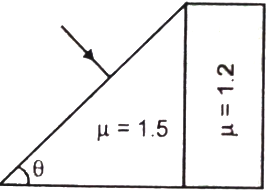The reflected light wave and incident light wave differ each other by a phase angle of , when
1. Light enters into glass from air
2. Light enters into air from glass
3. Light enters into glass from diamond
4. Light enters into water from glass
Converging rays are incident on a convex lens, the image formed
(1) May be virtual
(2) Must be virtual
(3) May be real
(4) Must be real
A small source of light is \(2\) m below the surface of a liquid of refractive index \(\frac{5}{3}.\) In order to block all the light coming out of the liquid surface, the minimum diameter of the displaced on the surface of the liquid is:
1. 3m
2. 4m
3. 6m
4. 1.5m
A glass slab is placed with the right angle prism as shown in the figure. The possible value of such that light incident normally on the prism does not pass through the glass slab is:

1.
2.
3.
4. Both 1 & 2
A concave lens forms the image of an object such that the distance between the object and image is 10 cm. If magnification of the image is . The focal length of the lens is
(1) 6 cm
(2)
(3)
(4)
When an object is placed at 10 cm and 30 cm from a convex lens images obtained are of the same magnitude of magnification. The focal length of the lens maybe:
(1) 10 cm
(2) 15 cm
(3) 20 cm
(4) 25 cm
To increase the magnifying power of a telescope:
| 1. | The focal length of the eyepiece should be increased. |
| 2. | The focal length of the objective should be increased. |
| 3. | The wavelength of light should be increased. |
| 4. | The aperture of the eyepiece should be increased. |
A ray of light is incident on a prism of angle A and refractive index will not emerge out of prism for any angle of incidence, if
(1)
(2)
(3)
(4)
What should be the maximum angle of acceptance at the air core interface of an optical fiber, if are the refractive indices of the core and the cladding respectively?
(1)
(2)
(3)
(4)
| 1. | \(80~\text{cm}\) | 2. | \(40~\text{cm}\) |
| 3. | \(60~\text{cm}\) | 4. | \(20~\text{cm}\) |






